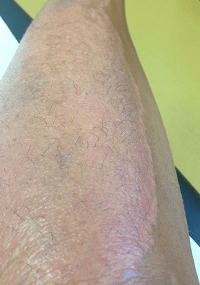1. Shuster S. Psoriatic alopecia. Br J Dermatol. 1972; 87: 73-77. doi: 10.1111/j.1365-2133.1972.tb05103.x
2. Schoorl WJ, Van Baar HJ, Kerkhof PC. The hair root pattern in psoriasis of the scalp. Acta derm Venereol. 1992; 72: 141-142. Web site. http://europepmc.org/abstract/med/1350403. Accessed February 14, 2017.
3. Kasumagić-Halilović E, Prohić A, Begović B. TrichoScan as a method to determine hair root pattern in patients with scalp psoriasis. Acta Dermatovenerol Croat. 2010;18: 146-150.
4. Rittié L, Tejasvi T, Harms PW, et al. Sebaceous gland atrophy in psoriasis: An explanation for psoriatic alopecia? J Invest Dermatol. 2016; 136(9): 1792-1800. doi: 10.1016/j.jid.2016.05.113
5. Sawan S, Descamps V. Scalp psoriasis: A paradigm of “switch-on” mechanism to anagen hair growth? Arch Dermatol. 2008; 144(8): 1064-1066. doi: 10.1001/archdermatol.2008.2
6. Paus R, Link RE. The psoriatic epidermal lesion and anagen hair growth may share the same “switch-on” mechanism. Yale J Biol Med. 1988; 61(5): 467-476.
7. Hampton PJ, Ross OK, Reynolds NJ. Increased nuclear beta-catenin in suprabasal involved psoriatic epidermis. Br J Dermatol. 2007; 157(6): 1168-1177. doi: 10.1111/j.1365-2133.2007.08195.x
8. Lo Celso C, Prowse DM, Watt FM. Transient activation of beta-catenin signalling in adult mouse epidermis is sufficient to induce new hair follicles but continuous activation is required to maintain hair follicle tumours. Development. 2004; 131(8): 1787-1799. doi: 10.1242/dev.01052
9. Gudjonsson JE, Johnston A, Stoll SW, et al. Evidence for altered Wnt siganaling in psoriasis skin. J Invest Dermatol. 2010; 130: 1849-1859. doi: 10.1038/jid.2010.67
10. Xing Y, Ma X, Guo H, Deng F, Yang J, Li Y. Wnt5a Suppresses β-catenin Signaling during Hair Follicle Regeneration. Int J Med Sci. 2016; 13: 603-610. doi: 10.7150/ijms.15571
11. Mikels AJ, Nusse R. Purified Wnt5a protein activates or inhibits beta-catenin-TCF signaling depending on receptor context. PLoS Biol. 2006; 4: e115. doi: 10.1371/journal.pbio.0040115






